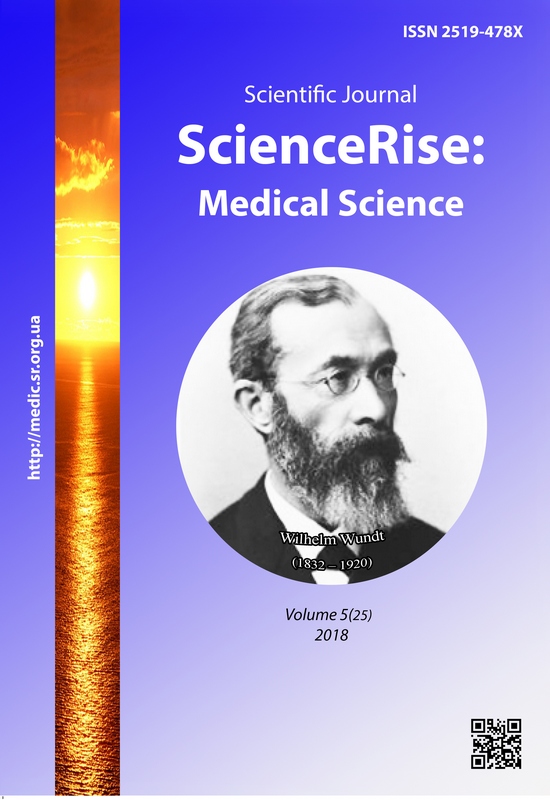Pharmacological prospects of treatment of spinal cord injury in acute and early periods
DOI:
https://doi.org/10.15587/2519-4798.2018.139760Keywords:
glutamatergic excitotoxicity, spinal cord injury, riluzole, MRIAbstract
Glutamatergic excitotoxicity is the main factor affecting the formation of edema, ischemia with a spinal cord injury. In our clinical studies, we analyzed the effectiveness of standard complex treatment - surgical and medicamentous with the use of riluzole as an inhibitor of glutamate release.
The aim of the study was to investigate the clinical efficacy of riluzole in patients with spinal and spinal cord injury in acute and early periods.
Materials and methods. On treatment in KU "Dnepropetrovsk Regional Clinical Hospital named after I.I. Mechnikov", from January 2013 to January 2017 there were 15 patients with complicated spinal cord injury of the cervical spine, which in the complex standard therapy used riluzole. The age of the patients was 18-70 years. The degree of severity of neurological disorders of patients on the ASIA scale corresponded to A-D. The use of riluzole started as early as possible, but no later than 7 days, at a dose of 50 mg every 12 hours for 3 weeks per os.
Results. In a group of patients with ASIA-A neurological disorders (6 patients), a neurological improvement in the ASIA scale was noted in one patient. In patients with ASIA-B (5 patients), in 2 cases a transition to group "C" was noted. The evaluation was carried out for 21 days. Movement in the key muscle groups corresponded to 1-2 points. Neurogenic shock was absent in all cases.
In 3 observations with violation of ASIA-C on day 21, movements were restored to 4 points in 2 patients. In 1 patient on the ASIA scale, the disorders corresponded to level "D". When examined after 3 weeks, there was no convincing difference in muscle strength.
Conclusions:
1. The use of riluzole limits the development of secondary changes in the spinal cord in the acute and early periods of spinal cord injury.
2. The medicine reduces the manifestation of muscle spasticity in the early period of trauma.
3. Neurogenic shock when taking riluzole is less prolonged.
4. The complex approach in treatment with the use of riluzole opens significant prospects in the treatment of this pathology
References
- Azbill, R., Mu, X., Springer, J. (2000). Riluzole increases high-affinity glutamate uptake in rat spinal cord synaptosomes. Brain Research, 871 (2), 175–180. doi: http://doi.org/10.1016/s0006-8993(00)02430-6
- Fehlings, M. G., Vaccaro, A. R., Boakye, M. et. al. (Ed.) (2013). Essentials of Spinal Cord Injury: Basic Research to Clinical Practice. New York: Thieme, 684.
- Li, S., Mealing, G. A. R., Morley, P., Stys, P. K. (1999). Novel Injury Mechanism in Anoxia and Trauma of Spinal Cord White Matter: Glutamate Release via Reverse Na+-dependent Glutamate Transport. The Journal of Neuroscience, 19 (14), 16. doi: http://doi.org/10.1523/jneurosci.19-14-j0002.1999
- Liu, J., Wang, L.-N. (2017). The efficacy and safety of riluzole for neurodegenerative movement disorders: a systematic review with meta-analysis. Drug Delivery, 25 (1), 43–48. doi: http://doi.org/10.1080/10717544.2017.1413446
- Mu, X., Azbill, R. D., Springer, J. E. (2000). Riluzole and Methylprednisolone Combined Treatment Improves Functional Recovery in Traumatic Spinal Cord Injury. Journal of Neurotrauma, 17 (9), 773–780. doi: http://doi.org/10.1089/neu.2000.17.773
- Nashmi, R., Fehlings, M. (2001). Changes in axonal physiology and morphology after chronic compressive injury of the rat thoracic spinal cord. Neuroscience, 104 (1), 235–251. doi: http://doi.org/10.1016/s0306-4522(01)00009-4
- Tator, C. H. (1995). Update on the Pathophysiology and Pathology of Acute Spinal Cord Injury. Brain Pathology, 5 (4), 407–413. doi: http://doi.org/10.1111/j.1750-3639.1995.tb00619.x
- Salkov, M., Tsymbaliuk, V., Dzyak, L., Rodinsky, A., Cherednichenko, Y., Titov, G. (2016). New concept of pathogenesis of impaired circulation in traumatic cervical spinal cord injury and its impact on disease severity: case series of four patients. European Spine Journal, 25(1), 11–18. doi: http://doi.org/10.1007/s00586-015-4015-x
- Salkov, M., Zozylia, N. (2015). New Concept of the Development of Brainstem Ischemia in the Setting of Occlusions of the Vertebral Arteries and Radicular and Medullary Arteries in the Presence of the Cervical Spinal Injury. Brain Disorders & Therapy, 4 (5). doi: http://doi.org/10.4172/2168-975x.1000193
- Salkov, M., Zozylia, N. (2018). New concept of the development of spinal cord ischemia in the presence of the cervical spinal injury. SF J Bone Spine, 1 (1).
Downloads
Published
How to Cite
Issue
Section
License
Copyright (c) 2018 Mykola Salkov

This work is licensed under a Creative Commons Attribution 4.0 International License.
Our journal abides by the Creative Commons CC BY copyright rights and permissions for open access journals.
Authors, who are published in this journal, agree to the following conditions:
1. The authors reserve the right to authorship of the work and pass the first publication right of this work to the journal under the terms of a Creative Commons CC BY, which allows others to freely distribute the published research with the obligatory reference to the authors of the original work and the first publication of the work in this journal.
2. The authors have the right to conclude separate supplement agreements that relate to non-exclusive work distribution in the form in which it has been published by the journal (for example, to upload the work to the online storage of the journal or publish it as part of a monograph), provided that the reference to the first publication of the work in this journal is included.









